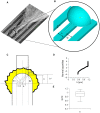Cell guidance on nanogratings: a computational model of the interplay between PC12 growth cones and nanostructures
- PMID: 23936404
- PMCID: PMC3735603
- DOI: 10.1371/journal.pone.0070304
Cell guidance on nanogratings: a computational model of the interplay between PC12 growth cones and nanostructures
Abstract
Background: Recently, the effects of nanogratings have been investigated on PC12 with respect to cell polarity, neuronal differentiation, migration, maturation of focal adhesions and alignment of neurites.
Methodology/principal findings: A synergistic procedure was used to study the mechanism of alignment of PC12 neurites with respect to the main direction of nanogratings. Finite Element simulations were used to qualitatively assess the distribution of stresses at the interface between non-spread growth cones and filopodia, and to study their dependence on filopodial length and orientation. After modelling all adhesions under non-spread growth cone and filopodial protrusions, the values of local stress maxima resulted from the length of filopodia. Since the stress was assumed to be the main triggering cause leading to the increase and stabilization of filopodia, the position of the local maxima was directly related to the orientation of neurites. An analytic closed form equation was then written to quantitatively assess the average ridge width needed to achieve a given neuritic alignment (R(2) = 0.96), and the alignment course, when the ridge depth varied (R(2) = 0.97). A computational framework was implemented within an improved free Java environment (CX3D) and in silico simulations were carried out to reproduce and predict biological experiments. No significant differences were found between biological experiments and in silico simulations (alignment, p = 0.3571; tortuosity, p = 0.2236) with a standard level of confidence (95%).
Conclusions/significance: A mechanism involved in filopodial sensing of nanogratings is proposed and modelled through a synergistic use of FE models, theoretical equations and in silico simulations. This approach shows the importance of the neuritic terminal geometry, and the key role of the distribution of the adhesion constraints for the cell/substrate coupling process. Finally, the effects of the geometry of nanogratings were explicitly considered in cell/surface interactions thanks to the analytic framework presented in this work.
Conflict of interest statement
Figures





 –2
–2 where
where  was the radius of the non-spread growth cone. All values were normalized on the interface VM stress at 0° for a length of 0.001
was the radius of the non-spread growth cone. All values were normalized on the interface VM stress at 0° for a length of 0.001 .
.


Similar articles
-
Topographical strategies to control neural outgrowth.Annu Int Conf IEEE Eng Med Biol Soc. 2015;2015:7147-50. doi: 10.1109/EMBC.2015.7320040. Annu Int Conf IEEE Eng Med Biol Soc. 2015. PMID: 26737940
-
The effect of alternative neuronal differentiation pathways on PC12 cell adhesion and neurite alignment to nanogratings.Biomaterials. 2010 Mar;31(9):2565-73. doi: 10.1016/j.biomaterials.2009.12.010. Epub 2009 Dec 24. Biomaterials. 2010. PMID: 20035995
-
Formin 2 regulates the stabilization of filopodial tip adhesions in growth cones and affects neuronal outgrowth and pathfinding in vivo.Development. 2016 Feb 1;143(3):449-60. doi: 10.1242/dev.130104. Epub 2015 Dec 30. Development. 2016. PMID: 26718007
-
Deterministic control of mean alignment and elongation of neuron-like cells by grating geometry: a computational approach.Integr Biol (Camb). 2015 Oct;7(10):1242-52. doi: 10.1039/c5ib00045a. Epub 2015 Jun 26. Integr Biol (Camb). 2015. PMID: 26114801
-
Drebrin in Neuronal Migration and Axonal Growth.Adv Exp Med Biol. 2017;1006:141-155. doi: 10.1007/978-4-431-56550-5_9. Adv Exp Med Biol. 2017. PMID: 28865019 Review.
Cited by
-
Some Mechanical Constraints to the Biomimicry with Peripheral Nerves.Biomimetics (Basel). 2023 Nov 13;8(7):544. doi: 10.3390/biomimetics8070544. Biomimetics (Basel). 2023. PMID: 37999185 Free PMC article.
-
Neuronal contact guidance and YAP signaling on ultra-small nanogratings.Sci Rep. 2020 Feb 28;10(1):3742. doi: 10.1038/s41598-020-60745-5. Sci Rep. 2020. PMID: 32111918 Free PMC article.
-
A developmental approach to predicting neuronal connectivity from small biological datasets: a gradient-based neuron growth model.PLoS One. 2014 Feb 21;9(2):e89461. doi: 10.1371/journal.pone.0089461. eCollection 2014. PLoS One. 2014. PMID: 24586794 Free PMC article.
-
Conducting polymer nanowires for control of local protein concentration in solution.J Phys D Appl Phys. 2017 May 4;50(17):174003. doi: 10.1088/1361-6463/aa60b0. Epub 2017 Mar 31. J Phys D Appl Phys. 2017. PMID: 34045776 Free PMC article.
-
A unified approach to model peripheral nerves across different animal species.PeerJ. 2017 Nov 10;5:e4005. doi: 10.7717/peerj.4005. eCollection 2017. PeerJ. 2017. PMID: 29142788 Free PMC article.
References
-
- Arimura N, Kaibuchi K (2007) Neuronal polarity: from extracellular signals to intracellular mechanisms. Nat Rev Neurosci 8: 194–205. - PubMed
Publication types
MeSH terms
LinkOut - more resources
Full Text Sources
Other Literature Sources

